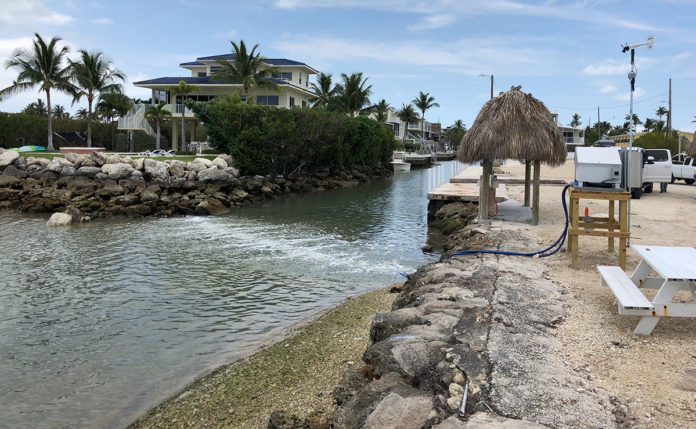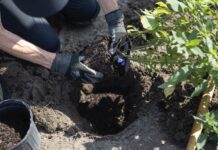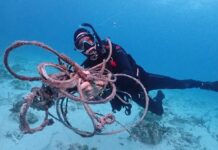A long-term plan to improve water quality and reduce sediment buildup in 63 village canals could cost well over $300 million.
That’s according to a recent report that ranks each canal based on restoration needs and identifies technologies recommended to improve water quality.
Backfill and culvert work for what’s identified as canal 150 in the report on Lower Matecumbe Key has an estimated cost of $41 million. Located within Port Antigua, it’s the project with the highest price tag and No. 23 on the rankings list.
In the report prepared by Wood Environment & Infrastructure Solutions Inc., canals ranked at the top for restoration were based on a number of factors, which include water quality, evidence of nutrient accumulation and likelihood of toxicity. Canals discharging into Florida Bay or the Atlantic Ocean scored higher, and restoration technology, cost, homeowner interest and public benefit were also taken into account.
A canal located on Lower Matecumbe Key scoring the highest is recommended to undergo weedgate, organic removal and backfilling. Estimated restoration costs for canal 147, between Leserra and Atlantic lanes, are around $2.2 million. An injection well and backfilling recommended for canal 132, the second-ranked project located between North and South drives on Plantation Key, shows costs around $2 million.
Peter Frezza, village environmental resources manager, said the rankings list will evolve based on a number of factors.
“It will change a lot based on the updated water quality information we receive,” he said. “We’re going to have changes in technology and homeowner interest,” he said. “These projects won’t happen if we don’t have good support from residents.”
Implementation of a canal restoration program started in the village in 2014 to address poor water quality canals. One of the first steps was to objectively and scientifically select canals for water quality improvements.


THE HISTORY
What began as a push to address septics and cesspits through implementation of a central wastewater system has now transitioned to canal restoration. It’s all part of the Florida legislature’s designation of the Keys as an area of critical state concern in the early 1970s. With the intent to protect the natural environment and property rights also came assurance that a Keys population could evacuate 24 hours before a Category 3 or higher storm.
Work plans were adopted for Monroe County and cities with specific tasks for each local government to achieve. Each program was developed in recognition of the fact that these communities contain an important habitat that needs protection.
With a central sewer system in place per a state requirement, and millions spent to get it done, municipalities including Islamorada are shifting focus to canal restoration. In 2011, the state identified the lack of dissolved oxygen in canal systems as a key issue needing to be addressed. A canal master plan was approved, which provided a framework to examine some 500 Keys canals.
By 2014, Keys municipalities initiated a canal demonstration program — funded locally — to identify and implement technologies best suited to improve water quality. Five technologies were identified: organic removal, backfilling, culverts, air curtains and pumping. Meanwhile, Florida International University researchers were measuring water quality and benthic habitat improvements associated with canals within the demonstration project.
Hurricane Irma shifted restoration to recovery, as municipalities received funding from the U.S. Department of Agriculture to remove marine debris and sediment from the canals. That was completed toward the late stages of 2020 and early 2021.
“I think we’ve made some great progress over the past few years, but I also feel like we’re just getting started with the canal restoration work plan,” Frezza told council members during a recent council meeting.
COMPLETED CANAL PROJECTS
Several canal restoration projects within the village saw completion, including canal 148 located between Ocean and Sea lanes on Lower Matecumbe Key, facing the Atlantic Ocean. Greg Corning, lead engineer with Wood Environmental Solutions, said an air curtain, weed barrier was installed. Diffusers placed along the bottom of the canal’s mouth will prevent seaweed from entering and filling up and causing water degradation.
Canal 145, located between Columbus and Cortez drives, on Lower Matecumbe was a public-private partnership that saw an air curtain installed at the canal’s mouth. An air curtain and aeration system upgrades within the basin were installed at canal 137 at Treasure Harbor on Plantation Key.
Canal 114 located at Tropical Atlantic Shores on Plantation Keys saw the installation of a gravity injection well, also known as a vertical culvert.
“Basically what we’re doing is we’re turning those culverts that we’re going to connect horizontally to dead-end canals, and we’re flipping upside down and we’re going to connect to the water below it,” Corning said.
THE FUNDING
“I know you’re thinking we have to do $319 million in a 10-year program? No, it’s showing progress,” Frezza told the dais. “It’s all about looking at potential funding availability that the village has to implement projects.”
There hasn’t been specific funds for the canal work plan or sources designated for canal restoration projects. But Frezza said funding from the Florida Keys Stewardship Act could be a major funding source for projects.
“We’re identifying other funding sources. We have a project program with the Army Corps of Engineers where we could get some significant funding for the rest of the projects,” Frezza said. “There are other state and federal grants as well that can fund these projects.”



























